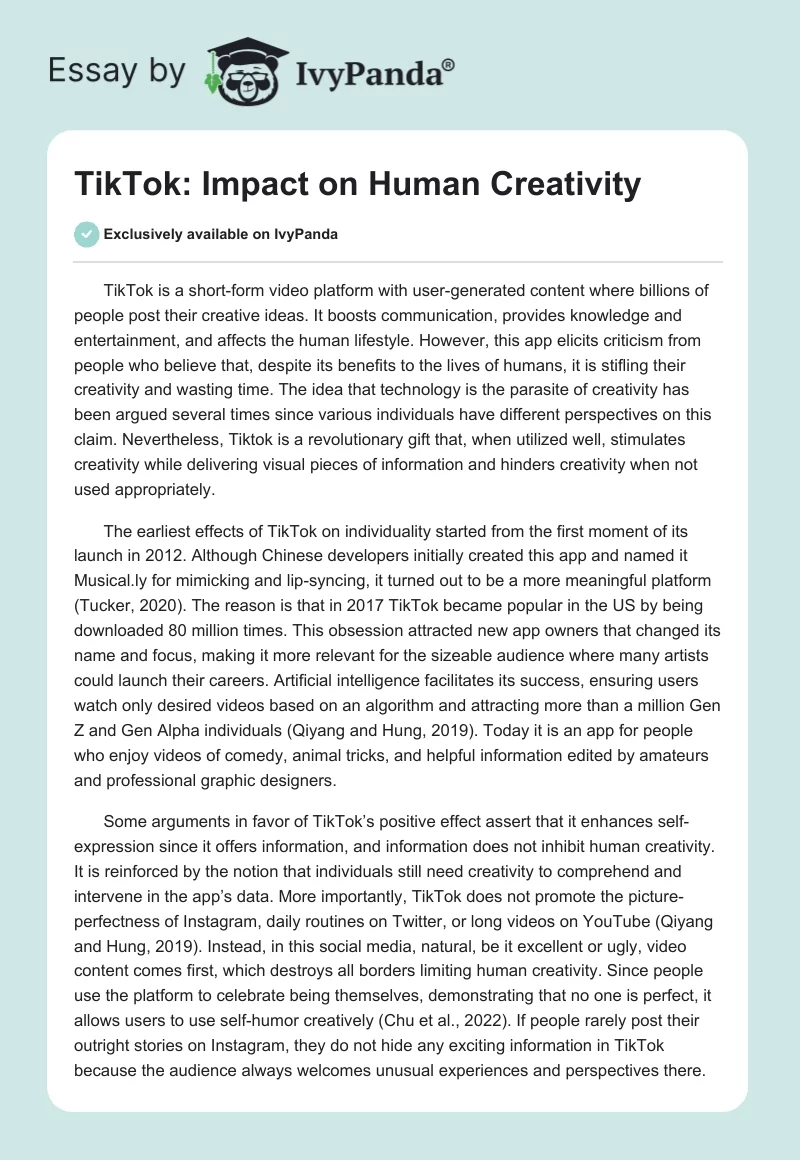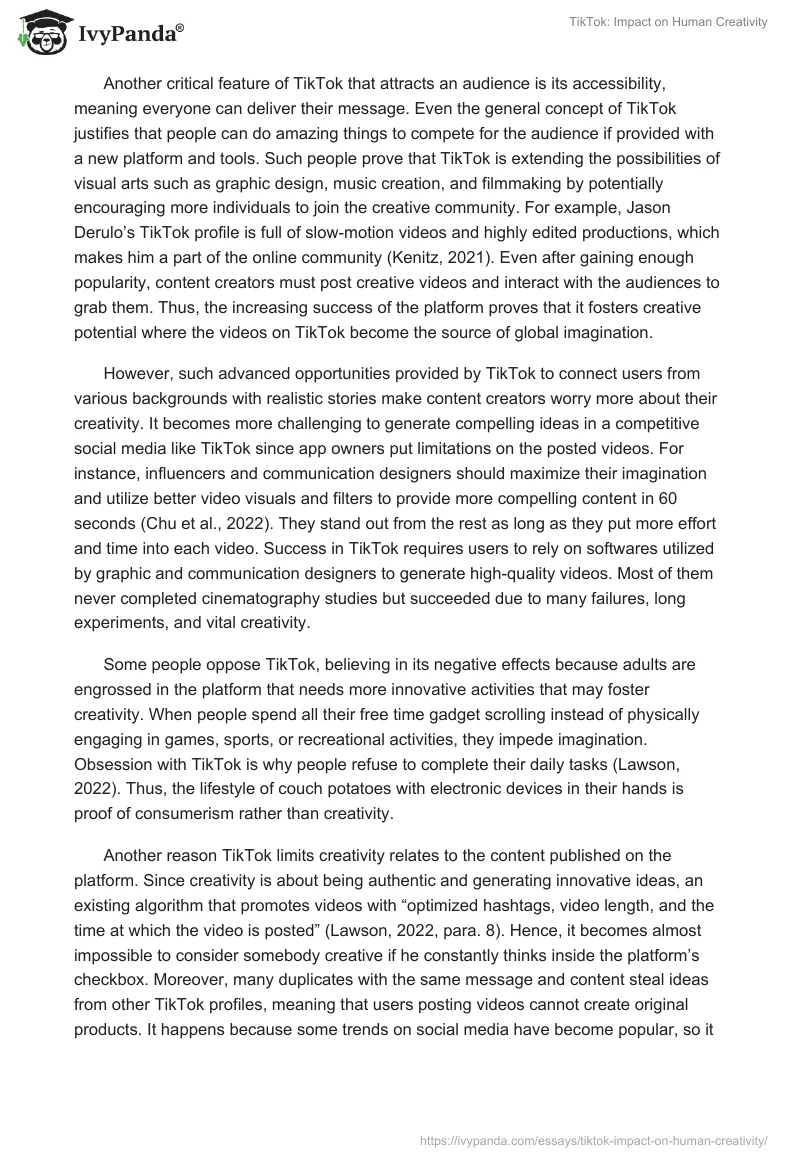TikTok is a short-form video platform with user-generated content where billions of people post their creative ideas. It boosts communication, provides knowledge and entertainment, and affects the human lifestyle. However, this app elicits criticism from people who believe that, despite its benefits to the lives of humans, it is stifling their creativity and wasting time. The idea that technology is the parasite of creativity has been argued several times since various individuals have different perspectives on this claim. Nevertheless, Tiktok is a revolutionary gift that, when utilized well, stimulates creativity while delivering visual pieces of information and hinders creativity when not used appropriately.
The earliest effects of TikTok on individuality started from the first moment of its launch in 2012. Although Chinese developers initially created this app and named it Musical.ly for mimicking and lip-syncing, it turned out to be a more meaningful platform (Tucker, 2020). The reason is that in 2017 TikTok became popular in the US by being downloaded 80 million times. This obsession attracted new app owners that changed its name and focus, making it more relevant for the sizeable audience where many artists could launch their careers. Artificial intelligence facilitates its success, ensuring users watch only desired videos based on an algorithm and attracting more than a million Gen Z and Gen Alpha individuals (Qiyang and Hung, 2019). Today it is an app for people who enjoy videos of comedy, animal tricks, and helpful information edited by amateurs and professional graphic designers.
Some arguments in favor of TikTok’s positive effect assert that it enhances self-expression since it offers information, and information does not inhibit human creativity. It is reinforced by the notion that individuals still need creativity to comprehend and intervene in the app’s data. More importantly, TikTok does not promote the picture-perfectness of Instagram, daily routines on Twitter, or long videos on YouTube (Qiyang and Hung, 2019). Instead, in this social media, natural, be it excellent or ugly, video content comes first, which destroys all borders limiting human creativity. Since people use the platform to celebrate being themselves, demonstrating that no one is perfect, it allows users to use self-humor creatively (Chu et al., 2022). If people rarely post their outright stories on Instagram, they do not hide any exciting information in TikTok because the audience always welcomes unusual experiences and perspectives there.
Another critical feature of TikTok that attracts an audience is its accessibility, meaning everyone can deliver their message. Even the general concept of TikTok justifies that people can do amazing things to compete for the audience if provided with a new platform and tools. Such people prove that TikTok is extending the possibilities of visual arts such as graphic design, music creation, and filmmaking by potentially encouraging more individuals to join the creative community. For example, Jason Derulo’s TikTok profile is full of slow-motion videos and highly edited productions, which makes him a part of the online community (Kenitz, 2021). Even after gaining enough popularity, content creators must post creative videos and interact with the audiences to grab them. Thus, the increasing success of the platform proves that it fosters creative potential where the videos on TikTok become the source of global imagination.
However, such advanced opportunities provided by TikTok to connect users from various backgrounds with realistic stories make content creators worry more about their creativity. It becomes more challenging to generate compelling ideas in a competitive social media like TikTok since app owners put limitations on the posted videos. For instance, influencers and communication designers should maximize their imagination and utilize better video visuals and filters to provide more compelling content in 60 seconds (Chu et al., 2022). They stand out from the rest as long as they put more effort and time into each video. Success in TikTok requires users to rely on softwares utilized by graphic and communication designers to generate high-quality videos. Most of them never completed cinematography studies but succeeded due to many failures, long experiments, and vital creativity.
Some people oppose TikTok, believing in its negative effects because adults are engrossed in the platform that needs more innovative activities that may foster creativity. When people spend all their free time gadget scrolling instead of physically engaging in games, sports, or recreational activities, they impede imagination. Obsession with TikTok is why people refuse to complete their daily tasks (Lawson, 2022). Thus, the lifestyle of couch potatoes with electronic devices in their hands is proof of consumerism rather than creativity.
Another reason TikTok limits creativity relates to the content published on the platform. Since creativity is about being authentic and generating innovative ideas, an existing algorithm that promotes videos with “optimized hashtags, video length, and the time at which the video is posted” (Lawson, 2022, para. 8). Hence, it becomes almost impossible to consider somebody creative if he constantly thinks inside the platform’s checkbox. Moreover, many duplicates with the same message and content steal ideas from other TikTok profiles, meaning that users posting videos cannot create original products. It happens because some trends on social media have become popular, so it is impossible to neglect them. It is how the posts that intended to highlight the originality of some groups become over-popularized trends.
The points mentioned above highlight that TikTok can enhance and inhibit human creativity. Finding a balance between two extremes is critical to foster imagination. When people do not spend all day scrolling through their feeds, they have enough time for physical and mental activities stimulating their creativity. Regarding content creators, they should learn to provide their ideas and visual arts to grab an audience instead of copying their competitors. If the initial concept of the platform requiring people to be realistic about their thoughts and experiences remains, there will be enough outstanding creators with authentic styles. Since TikTok brings everything within reach to the point where people no longer strain their minds to figure out how to make something available, engaging with the audience to find standard solutions could be helpful for creativity. The most vital aspect is sharing ideas, talking, and exchanging views when individuals congregate in a room instead of watching TikTok videos.
To conclude, TikTok is a video platform with billions of users worldwide enjoying funny and helpful content. It stifles human creativity by requiring individuals to spend all their time on electronics, making everything accessible, copying everyone, and fitting into TikTok’s promotional algorithm. However, it also fosters visual arts and imagination by providing valuable information and exciting tools and encouraging people to be honest. Nevertheless, it is possible to control the use of TikTok to compensate for the lack of uniqueness and substance. If people learn to post authentic ideas, limit time spent online, and utilize TikTok to their advantage, global trends of passive consumerism shift to creativity.
Reference List
Chu, S. C., Deng, T., and Mundel, J. (2022) “The impact of personalization on viral behavior intentions on TikTok: The role of perceived creativity, authenticity, and need for uniqueness,” Journal of Marketing Communications, 2(1), pp. 1-20. Web.
Kenitz, D. (2021) “13 TikTok starts and how they rose to fam,” Skillshare Blog. Web.
Lawson, L. (2022) “Art and algorithms: How TikTok is threatening creativity,” The Boar, Web.
Qiyang, Z. and Jung, H. (2019) “Learning and sharing creative skills with short videos: A case study of user behavior in tiktok and bilibili,” International Association of Societies of Design research, 5(2), pp. 1–15. Web.
Tucker, J. A. (2020) “What brilliant TikTok reveals about human creativity,” American Institute for Economic Research, Web.


